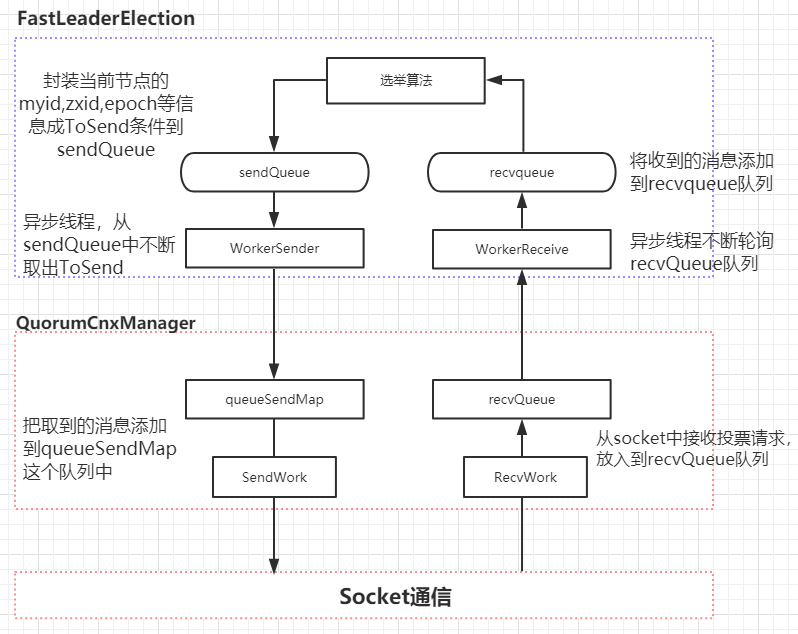通信流程图:


接收数据 Notification 和发送 ToSend
|
ToSender
|
Notification |
|
leader; 被推荐的服务器 sid
zxid; 被推荐的服务器当前最新的事务 id
peerEpoch; 被推荐的服务器当前所处的 epoch
electionepoch; 当前服务器所处的 epoch
stat 当前服务器状态
sid 接收消息的服务器 sid(myid)
|
leader; //被推荐的服务器 sid
zxid; 被推荐的服务器最新事务 id
peerEpoch; 被推荐的服务器当前所处的 epoch
electionEpoch 选举服务器所处的 epoch
stat; 选举服务器当前的状态
sid; 选举服务器的 sid
|
通信过程源码分析
每个 zk 服务启动后创建 socket 监听
protected Election createElectionAlgorithm(int electionAlgorithm){
//….
case 3:
qcm = createCnxnManager();
QuorumCnxManager.Listener listener =
qcm.listener;
if(listener != null){
listener.start();
}
// 启动监听listener 实现了线程,所以在 run 方法中可以看到构建ServerSocket 的请求,这里专门用来接收其他zkServer
// 的投票请求
// 这块后续再分析
@Override
public void run() {
int numRetries = 0;
InetSocketAddress addr;
while((!shutdown) && (numRetries < 3)){
try {
ss = new ServerSocket();
}
}
}
}
FastLeaderElection.lookForLeader
这个方法在前面分析过,里面会调用 sendNotifications 来发送投票请求
public Vote lookForLeader() throws InterruptedException {
//省略部分代码
sendNotifications(); //这个方法,会把当前zk 服务器的信息添加到 sendqueue
/*
* Loop in which we exchange
notifications until we find a leader
*/
while ((self.getPeerState() == ServerState.LOOKING) &&
//省略部分代码
}
FastLeaderElection.sendqueue
sendQueue 这个队列的数据,是通过 WorkerSender 来进行获取并发送的。而这个 WorkerSender 线程,在构建 fastLeaderElection 时,会启动
class WorkerSender extends ZooKeeperThread {
public void run() {
while (!stop) {
try {//从队列中获取 ToSend 对象
ToSend m = sendqueue.poll(3000, TimeUnit.MILLISECONDS);
if(m == null) continue;
process(m);
//省略部分代码
void process(ToSend m) {
ByteBuffer requestBuffer = buildMsg(m.state.ordinal(),
m.leader, m.zxid,
m.electionEpoch,
m.peerEpoch);
manager.toSend(m.sid, requestBuffer); // 这里就是调用 QuorumCnxManager
// 进行消息发送
}
}
}
}
}
QuorumCnxManager.toSend
public void toSend(Long sid, ByteBuffer b) {
if (this.mySid == sid) { // 如果接受者是自己,直接放置到接收队列
b.position(0);
addToRecvQueue(new Message(b.duplicate(), sid));
} else { // 否则发送到对应的发送队列上
ArrayBlockingQueue<ByteBuffer> bq = new ArrayBlockingQueue<ByteBuffer>(SEND_CAPACITY);
// 判断当前的 sid 是否已经存在于发送队列,如果是,则直接把已经存在的数据发送出去
ArrayBlockingQueue<ByteBuffer> bqExisting = queueSendMap.putIfAbsent(sid, bq);
if (bqExisting != null) {
addToSendQueue(bqExisting, b);
} else {
addToSendQueue(bq, b);
}
connectOne(sid); // 连接申请调用链 connectOne-->initiateConnection-
// ->startConnection , startConnection 就是发送方启动入口
}
}
startConnection
private boolean startConnection(Socket sock, Long sid) {
// 省略部分代码
if (sid > this.mySid) {
// 为了防止重复建立连接,只允许 sid 大的主动连接 sid 小的
closeSocket(sock);
} else {
// 构建一个发送线程和接收线程,负责针对当前连接的数据传递,后续的逻辑比较简单,就不做分析
SendWorker sw = new SendWorker(sock, sid);
RecvWorker rw = new RecvWorker(sock, din, sid, sw);
sw.setRecv(rw);
}
}
SendWorker 会监听对应 sid 的阻塞队列,启动的时候回如果队列为空时会重新发送一次最前最后的消息,以防上一次处理是服务器异常退出,造成上一条消息未处理成功;然后就是不停监听队里,发现有消息时调用send 方法RecvWorker:RecvWorker 不停监听 socket 的 inputstream,读取消息放到消息接收队列中,消息放入队列中,qcm 的流程就完毕了。
QuorumCnxManager.Listener
listener 监听到客户端请求之后,开始处理消息
public void run() {
// 省略部分代码
while (!shutdown) {
Socket client = ss.accept();
setSockOpts(client);
LOG.info("Received connection request" + client.getRemoteSocketAddress());
if (quorumSaslAuthEnabled) {
receiveConnectionAsync(client);
} else {
receiveConnection(client); // 接收客户端请求
}
}
}
QuorumCnxManager.receiveConnection
public void receiveConnection(final Socket sock) {
DataInputStream din = null;
try {
// 获取客户端的数据包
din = new DataInputStream(new BufferedInputStream(sock.getInputStream()));
handleConnection(sock, din);// 调用 handle 进行处理
} catch (IOException e) {
LOG.error("Exception handling connection, addr: {}, closing server connection",
sock.getRemoteSocketAddress());
closeSocket(sock);
}
}
handleConnection
private void handleConnection(Socket sock, DataInputStream din)throws IOException {
Long sid = null;
try {
//获取客户端的 sid,也就是 myid
sid = din.readLong();
if (sid < 0) {
sid = din.readLong();
if (sid < this.mySid) {
//为了防止重复建立连接,只允许 sid 大的主动连接 sid 小的
SendWorker sw = senderWorkerMap.get(sid);
if (sw != null) {
sw.finish();//关闭连接
}
LOG.debug("Create new connection to server: " + sid);
closeSocket(sock);//关闭连接
connectOne(sid);//向 sid 发起连接
} else {//同样,构建一个 SendWorker 和RecvWorker 进行发送和接收数据
SendWorker sw = new
SendWorker(sock, sid);
RecvWorker rw = new
RecvWorker(sock, din, sid, sw);
sw.setRecv(rw);
}
}
}
}